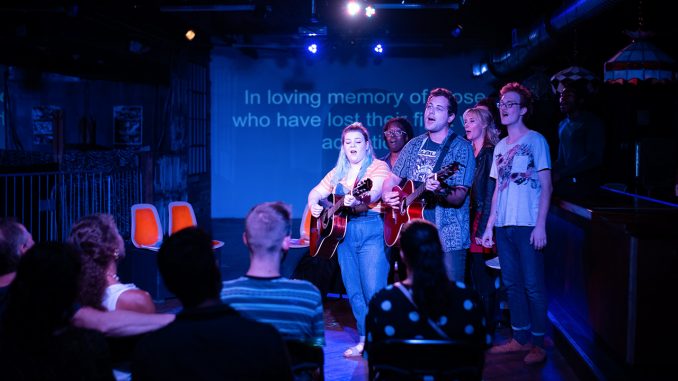
Amanda Shaffern was admitted into Alumni TIES, a state government exchange program, after studying abroad at Temple Rome in 2014. She usually brushed off their invitations to seminars on global issues, until she learned the theme for 2018: the opioid epidemic.
“I kept thinking about it and I had this idea,” said Shaffern, a 2015 theatre and speech pathology alumna. “There’s a lot of verbatim pieces that deal with hard issues … but I didn’t know of one that specifically centered on addiction.”
Shaffern, and Peter Loikits’, a 2017 theatre alumnus, debuted their play “Siren Songs” at this year’s Philadelphia Fringe Festival. The show follows seven people who are in recovery for opioid addiction. It ran from Sept. 6, to Sept. 15, and was performed at Warehouse on Watts between Cambridge and Watts streets.
To understand the tribulations of addiction and to prepare for the show, Shaffern and Loikits conducted more than 50 interviews with former opioid-users; seven of which are featured in “Siren Songs.”
The play seeks to raise awareness about substance use disorder, demystify stigmas and negative connotations surrounding it, like using the word “junkies,” said Loikits, the show’s director.
“It’s our statement, for us as artists, that this is a problem and we need to change it,” he added.
Shaffern and Loikits applied for a grant through Alumni TIES to fund the play, and after receiving it last year, they began creating a production that would start the conversation on substance use disorder.
else.” Peter Loikitis 2017 theater alumnus
Shaffern, the show’s producer, said that she centered the play primarily on the epidemic in Philadelphia as she mainly interviewed Philadelphians affected by it, but the epidemic is affecting people all over the country.
“These people are real, they’re human, and they deserve to have their stories told just like everyone else,” Loikits said.
The two alumni wanted to convey a more accurate and first-hand account of the subject. They achieved this by having the play be verbatim-style, meaning the dialogue is constructed on the precise words spoken by the interviewees.
“No one from what I had found, at least in the theatrical sense, had done it straight from the source,” Shaffern said. “We’re getting rid of all bias. We wanted to get a full 360-depiction, as best we could to help end an epidemic and to tell stories.”
Because the characters are based on real-life stories, their identities are anonymous and are defined by their case study number, age and gender.
Blake Lowry, a 2017 theatre alumnus at Columbus State University in Columbus, Georgia, played Case Study 10, a queer man in his 20s with substance use disorder, coming to terms with his sexuality. Though Lowry has never met his character is based on, he’s been able to sympathize and identify with his character.
“If I had been in the wrong place at the wrong time, I can see how I could’ve gone down that path easily,” Lowry said. “This crisis doesn’t discriminate against race, gender or social class. All you have to do is make that one wrong choice.”
In 2018, 1,116 overdose deaths were reported in Philadelphia, according to the Philadelphia Department of Public Health. Though drug overdoses declined by 8 percent, opioids were detected in approximately 84 percent of the total deaths that year.
Given these statistics, Shaffern and Loikits stress the importance of audience members empathizing with people who experienced opioid addiction and separating the person from the disease.
“You don’t know what people go through in general,” Shaffern said. “This show really opened my eyes. Yes, there’s the bad in the world, but there’s also hope that can come out of it. It made me see hope within people and empathize more.”


Be the first to comment